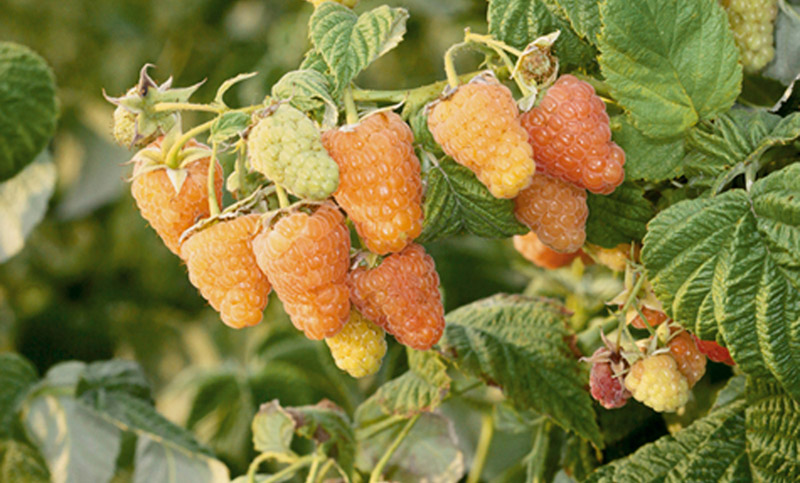In recent decades, ideas about raspberries, like red berries, have changed. Breeders brought new varieties of yellow, orange color, different sweet taste. Among them, the raspberry variety “Orange Miracle” should be noted.
The All-Russian Institute of Horticulture brought a view of the experimental station located in the Bryansk region, under the direction of I.V. Kazakova.
Table of contents
Description of bushes and berries of a repair raspberry of a grade Orange miracle
"Orange miracle" refers to srednerosly bushes, whose height ranges from one and a half to two meters. The branches of the bush are erect, but under the weight of the crop they can bend down a lot. Therefore, it is recommended when planting bushes immediately pull the tapestries.
They will keep the branches in an upright position, will create conditions for lighting the berries with the sun, the early ripening. The shoots are dotted with a large number of thorns that change color from green to brown. Five to seven new shoots are formed annually.
The repairing variety “Orange Miracle” has a high yield. The berries are yellow-orange in color and have a conical shape, slightly rounded at the bottom. Fruits of orange raspberries reach up to four centimeters. And their weight ranges from seven to twelve grams. The berries have a dense structure, which prevents premature shedding.
Variety "Orange Miracle" is famous for its rich aroma and sweet taste of berries. In hot sunny weather, the berries become bright orange, get a sweet taste. In cool summer, the color will be yellow rather than orange, and the taste will be sweet and sour. From one bush to two and a half kilograms of harvest.The variety is characterized by the fact that fruits are occupied up to 2/3 of the shoot.
Harvest time
Fruit ripening starts from the end of July. But the peak of the harvest begins from the second decade of August, continuing until the autumn frosts. In this case, before the cold ripens most of the ensuing berries.
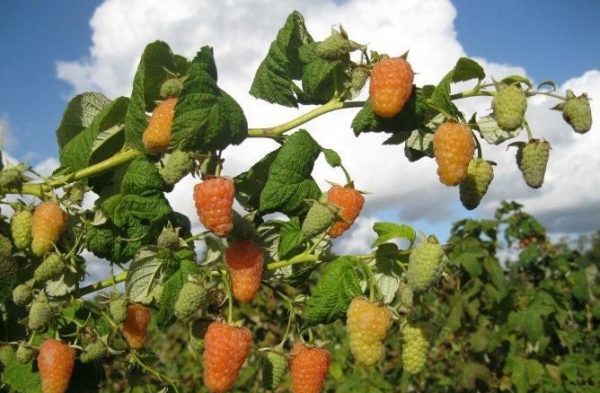
Advantages and disadvantages
"Orange miracle" is considered the best among remontant varieties of Russian breeding.Note the positive sides of this type:
- abundant annual harvest;
- low shedding of ripe berries on the branches;
- large berries;
- sweet taste good with rich aroma;
- use for making jam, jams and compotes;
- transportability;
- disease resistance;
- due to late flowering less likely to be affected by pests;
- wide climatic distribution.
Therefore, for the winter shoots are cut to the root, which allows to minimize the thickness of the shelter for raspberries for the winter.
Among these advantages are a number of disadvantages. Agronomists include a small number of young shoots instead of a cut branch. If the branches are not tied up, they can bend down heavily under the weight of the fruit., are damaged by strong wind, which leads to the deterioration of berries.
Variety "Orange Miracle" is different among related species high yield, sweet taste of berries and aroma. Shrub berries are hypoallergenic, so they can be given to young children and allergies. On the content of folic acid, they are superior to other varieties.
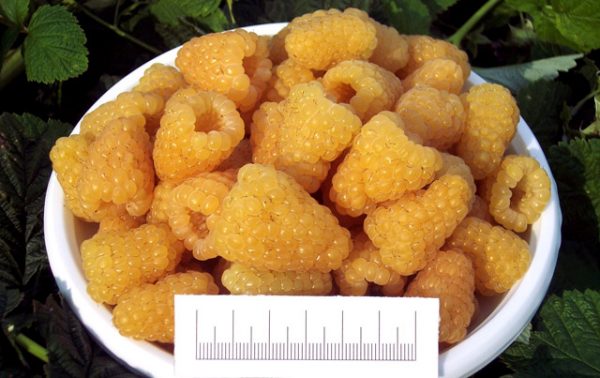
Reproduction and care of the bushes
For planting raspberry bushes pre-selected place. It should be sunny and protected from the north winds. This allows the soil to warm up faster, which stimulates the growth of young shoots. The developed branches start to blossom and fructify earlier, give a bigger crop.
Repairman's grade "Orange miracle" differs in unpretentiousness to soil type and climatic zone. The optimum soil for a raspberry of this grade will be light, loose soil, for example, loam, which is recommended to be enriched with compost, peat.
Stages of preparation
The bad forerunners for raspberries are potatoes, cucumbers, tomatoes, and eggplants. Therefore, it is worth to postpone the landing on this site. Consider the sequence of preparatory work.
- First determine the landing site. The bush method seedlings are planted with an interval of 0.4 m in length and a half meters between the rows. To avoid bending shoots under the weight of the crop, many agronomists recommend tying growing shoots to the trellis.
- At the first stage (one month before planting seedlings) prepare a mixture of humus (about 10 kg), superphosphate (15 g), potassium sulfate (45 g). Potassium can be replaced with wood ash (200 g). The finished composition is mixed with the top layer of earth.
- At landing sites digging holes half a meter deep, fill them with prepared humus with mineral fertilizers, compacted.
Before landing, a trench half a meter deep is dug near the holes. A mixture of fertilizers is poured into it. Per meter of trench required for a glass of superphosphate and potassium sulfate and a liter of wood ash.Trench covered with earth, rammed. This allows fertilizers along with moisture to gradually reach the roots, feeding them. The plot is ready for planting.
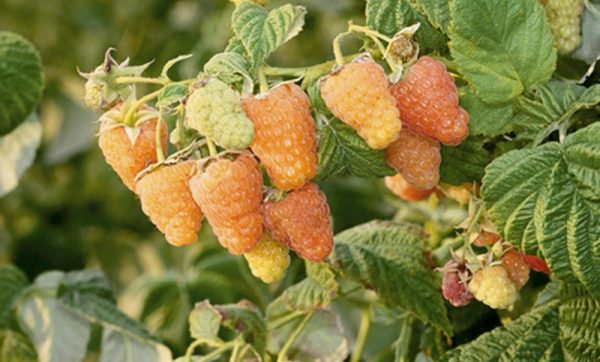
Selection of seedlings and planting time
The variety of raspberry can be planted in autumn, spring and early summer. To preserve the characteristics of the variety, use parts of rhizome or cuttings.
To multiply raspberries in your own area, you can separate the parts of the root with rhizomes in the fall and plant them in prepared holes. After winter, they will go well in growth. Saplings and cuttings are recommended to be planted in spring, in the summer, for their better rooting.
The procedure for planting seedlings is reduced to performing a number of simple actions:
- prepared wells are poured with water so that it is completely absorbed;
- in the center a mound forms, on top of which seedlings are placed, straightening the roots down the hill;
- the earth is poured in small portions with hands tamping;
- root neck should protrude over the edge of the earth after planting;
- making a shallow groove around the bush, watering the plant;
- after soaking up water, mulch the soil around, using for this purpose humus, straw, grass, sawdust, peat;
- layer of mulch should be at least five centimeters.
Long seedlings are shortened to thirty centimeters.
Peculiarities of care
In early spring, it is necessary to feed the bushes with mineral fertilizers. To accelerate the growth of shoots and strengthen the roots mixed nitrogen fertilizers (15g / m2), potassium or its organic substitute - wood ash (glass per square meter). Nitrogen fertilizers can be replaced with chicken manure compost. It is recommended to apply the first top dressing through the melting snow in a dry form so that the minerals with melt water penetrate to the roots.
One of the subtleties of care for the remontant raspberry is her love of moisturizing. Its roots are located at a shallow depth, so when watering the land is enough to irrigate so that the water penetrated to a depth of thirty centimeters. Watering should be carried out in the summer while tying berries and fruit ripening with warm water. After the earth dries up, it is gently and shallowly loosened. The ground around the bushes is mulched, which retains moisture, while simultaneously feeding the soil with humus.
Before flowering bushes, you can feed a mullein with complex fertilizers in the following ratio: in 10 liters of water, half a liter of mullein and 50 g of fertilizers are diluted. This amount is enough for five bushes.
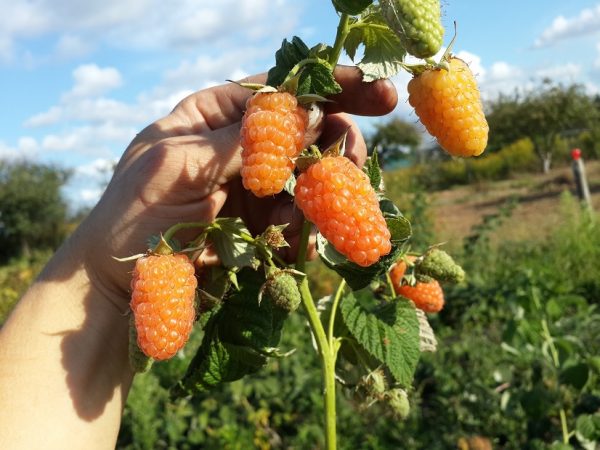
In early summer, weak shoots are removed from the bushes, leaving five or six of the strongest.
Remontant varieties are plants with a one-year development cycle. Their advantage is the short cycle of development - during the season shoots grow and bear fruit. In the autumn they dry up, and they are cut out at the root, leaving about three centimeters.
Cut bushes cover with straw, foliage, humus. Some gardeners harbor raspberries without cutting the shoots to prevent the growth of young stock in warm and late winter. In addition, large shoots contribute to snow retention, which increases the amount of moisture in the spring. Then circumcision is done in early spring, before the start of sap flow.
You may also be interested in the following articles about raspberries:
Diseases and pests
Although remontant raspberries are more resistant to various diseases and less commonly affected by insect pests, some diseases are also inherent in it.
- Chlorosis appears in the yellowing of the leaves on the tops, then the stems turn yellow. As a result, the berries dry up to maturity. In the initial stage, raspberries are sprayed with Cugoplex. If you can not cope with the disease, it remains a radical method - cut, uproot the bushes and burn. For prophylaxis, it is necessary to treat Nitrofen before blooming buds, and before flowering, methyl mercaptophos is sprayed. After this chemical, it is possible to collect raspberries only after a month and a half.
- Gray rot affects the berries, covering them with a gray bloom. Such berries are harvested and destroyed. Before hibernation, the bushes are treated with colloidal sulfur at a ratio of 100 g per bucket of water. Blossoming leaves - Kurposan or copper oxychloride. Pouring berries sprayed Fundazol, Ronilan. Supporters of organic methods of struggle are recommended to sprinkle the soil under the bush with ash or activated carbon powder.
- Rust causes red tubercles on the leaves and stems.To combat this disease, it is recommended to spray one-percent Bordeaux liquid after flowering and the end of the harvest. Before flowering raspberries treated with Nitrafen.
- Orange Miracle rarely sick anthracnose - gray spots, leading to the death of plants. If signs of the disease were observed, then Bordeaux liquid, copper oxychloride, is recommended for treatment.
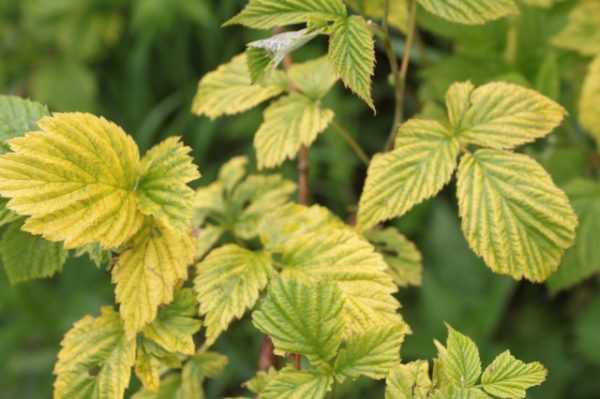
Among the pests, the raspberry "Orange Miracle" is more often affected by such insects: aphid, raspberry beetle, stem gallitsa. If the plant louse and beetle eat the leaves and flowers, then the gall midge manifests itself in the form of spherical growths on the shoots. For their destruction many different chemical preparations are produced, among which Karbofos, Konfidor or Aktara are the most popular. They are used according to the instructions.
In conclusion, we note that the achievements of Russian breeders in the cultivation of raspberry remontant varieties are valued by gardeners. Among them, the variety "Orange Miracle" is considered one of the best used in food and for blanks.
Reviews
Gagina Julia: Like this variety for a sweet taste. This year received the first harvest. On well-developed bushes - a large berry. Most of the fruits are large, beautiful.We hope that the yield will meet our expectations.
Mihail66: "Orange miracle" I was pleased with the yield, taste and size of the berries. Yesterday, my wife and I collected the first harvest. With one bush received more than a kilogram. Sores are not visible, the bush looks good. I just tied shoots, put props.
Svetlana Vitalevna: Berry is very sweet. The first berries have ripened, but the wind has risen, so many of the berries on the branches have been damaged. After the rain, a very ripe berry on the branches softens.
But everything is compensated by the taste and size of the fruit, their aroma. They make delicious fragrant jam and compote. I will grow the "Orange Miracle" on my site.
